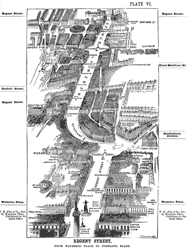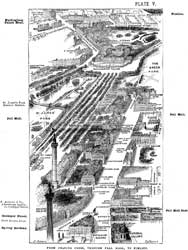Issue 12 : The Final Problem
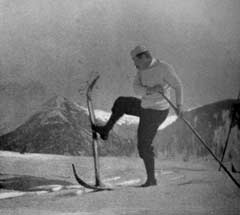 |
Conan
Doyle playing in the snow at around the time he "killed" Sherlock
Holmes. From The Strand Magazine (1894). |
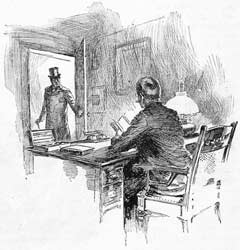 |
"It was with some
surprise, therefore, that I saw him walk into my consulting-room
upon the evening of the 24th of April." From McClure's
Magazine, vol. II, no. 1, January 1894. Illustrated by
Harry Edwards. |
It is with a heavy heart that I take up my pen to write these
the last words in which I shall ever record the singular gifts by
which my friend Mr. Sherlock Holmes was distinguished.
The Final Problem appeared in The Strand Magazine in December 1893, although the events narrated therein are supposed to take place in 1891. The Strand's reading public was outraged by what they considered the premature death of a beloved character. Over 20,000 people cancelled their subscriptions, and the magazine nearly went under. Forever after, The Strand's staff referred to Holmes's death as "the dreadful event."
At his "death" in "The Final Problem," Holmes is younger than most people think, perhaps because Sidney Padgett's drawings give him an air of maturity. In "His Last Bow," which takes place in 1914 (and is told in the third person, not by Watson), Conan Doyle puts Holmes's age at about 60. Holmes could have been born in or around 1854. In "The Final Problem," therefore, he is not yet 40.
…"Study in Scarlet," up to the time of his interference in the matter of the "Naval Treaty"….
A Study in Scarlet was the first Holmes and Watson story, a novelette published in Beeton's Christmas Annual in late 1887. "The Naval Treaty," published in The Strand in October and November, 1893, predated "The Final Problem" by a month.
As far as I know, there have been only three accounts in the public press: that in the Journal de Genève on May 6th, 1891, the Reuter's dispatch in the English papers on May 7th, and finally the recent letters to which I have alluded.
Reuters, opened in London in 1851 by a German immigrant named Paul Julius Reuter, began by reporting stock market quotations between European countries by telegraph. Where no telegraph lines had yet been strung, Reuter used carrier pigeons. Later, Reuters developed into a news dispatch service that used telegraph and radio to transmit the news from overseas to British newspapers.
…and I received two notes from Holmes, dated from Narbonne and from Nîmes….
Narbonne and Nîmes are French cities, both located in the south.
"Of air-guns."
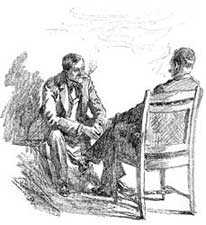 |
| "He saw the question in my eyes, and, putting his finger-tips together and his elbows upon his knees, he explained the situation." |
"At the age of twenty-one he wrote a treatise upon the Binomial Theorem, which has had a European vogue…."
Discovered by Euclid, and developed by Pascal and Newton, the binomial theorem expresses the expansion of a binomial (two variables added together) raised to a power.
"But the man had hereditary tendencies of the most diabolical kind. A criminal strain ran in his blood, which, instead of being modified, was increased and rendered infinitely more dangerous by his extraordinary mental powers."
Here, Conan Doyle refers to 19th-century scientist Cesare Lombroso's theory of the "born" or "atavistic" criminal. Moriarty is an exception among atavistic criminals who appear in literature, however; instead of having limited mental powers commensurate with his increased animal appetites, he possesses both criminal intent and extraordinary intelligence. Many readers have noticed that Moriarty is an evil twin of Holmes who turns his powers to crime instead of justice.
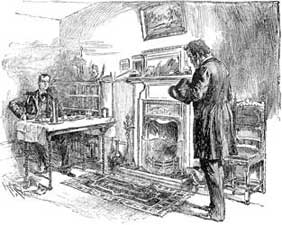 |
||
| "Never have I risen to such a height, and never have I been so hard pressed by an opponent." Compare this Moriarty to Sidney's Paget's--Edwards's is heavier, less reptilian, and more like a stereotypical villain from a melodrama. | ||
"…and the rope for all of them…."
In other words, they will all be hanged.
"I was sitting in my room thinking the matter over, when the door opened and Professor Moriarty stood before me."
Moriarty only appears in two Holmes stories: "The Final Problem" and the last of the four Holmes novels, The Valley of Fear. (Mycroft Holmes, Sherlock's brother, only appears in three, although he is mentioned in several others.) Nevertheless, readers have remained fascinated with Sherlock Holmes's dark opposite. Writers of pastiches of Conan Doyle's work have taken great liberties with Moriarty's character. Was he indeed "the Napoleon of crime," or was he an innocent scapegoat for some dark obsession of Holmes's? Modern reworkings of the Conan Doyle canon, such as Nicholas Meyer's The Seven Percent Solution, often concentrate on Holmes's unique psychology, in which Moriarty figures prominently.
Holmes describes Moriarty in reptilian terms, as if his lack of humanity can be discerned in his physical makeup.
"'You have less frontal development than I should have expected,' said he at last."
In the 18th-century pseudo-science, phrenology, frontal development was believed to indicate great intelligence. This idea, like other phrenological beliefs, eventually found its way into the anthropology of the time, which used racial characteristics as an indicator of evolutionary advancement. Moriarty's remark is meant as an insult to Holmes's brain capacity; Moriarty's own skull "domes out in a white curve," as Holmes himself notes.
"'You hope to place me in the dock. I tell you that I will never stand in the dock.'"
At British trials, the accused stands on a small platform surrounded by a railing--the dock.
"...I went out about midday to transact some business in Oxford Street. As I passed the corner which leads from Bentinck Street on to the Welbeck Street crossing a two-horse van furiously driven whizzed round and was on me like a flash."
These are the names of actual London streets. Holmes is just a few blocks from the foot of Baker Street when he is attacked.
The
area where Holmes was attacked can be found in the upper
left-hand corner of this map, and Mortimer Street, on which
Watson's back garden faces, appears at the upper right |
||
Vere Street turns into New Bond Street on the south side of Oxford Street.
"I took a cab after that and reached my brother's rooms in Pall Mall, where I spent the day."
Sherlock hides out at his brother Mycroft Holmes's lodgings, across the street from his club, the Diogenes, where speaking to another member can be cause for expulsion. Both Mycroft's apartment and the Diogenes Club are located near many other prestigious clubs, somewhere along Pall Mall, which runs horizontally across the bottom of the map, above right.
"…and you will drive to the Strand end of the Lowther Arcade…."
The Lowther Arcade is a small, covered shopping bazaar, specializing in toys, located between two buildings across The Strand from Charing Cross Station. The roof is studded with glass domes that provide natural light in the daytime.
Dear Lowther Arcade! Offtimes have we wandered agape among thy enchanted palaces…. I have heard that thou art vulgar, but I cannot see how, unless it be that tattered children haunt thy portals, those awful yet smiling entrances to so much joy. To the Arcade there are two entrances, and with much to be sung in laudation of that which opens from the Strand yet I on the whole prefer the other as truly romantic, because it is there the tattered ones congregate….
The passage
on the previous page is from J.M. Barrie (1860-1937), The Little
White Bird (1902), an early version of Peter Pan in Kensington
Gardens, which Barrie later wrote into his famous play, Peter
Pan. Barrie and Conan Doyle were close friends.
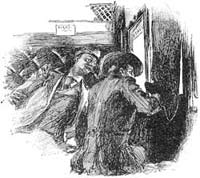 |
"'I
have reason to think that they are hot upon our trail. Ah,
there is Moriarty himself.'" |
If Watson's rooms backed on Mortimer Street, then he lived in an area near several hospitals, located quite close to the place where Holmes was attacked.
"It was my brother Mycroft."
Mycroft Holmes, known both for his brilliant mind and his sedentary habits, apparently made an exception to his usual aversion to action in order to accommodate Watson. Besides this story, he appears in two others, "The Greek Interpreter" and "The Bruce-Partington Plans," and is mentioned in two more. Mycroft is deeply involved behind the scenes in the British government.
"This train stops at Canterbury; and there is always at least a quarter of an hour's delay at the boat."
Canterbury is located on the way to Dover, a port at the end of a rail line on the south coast of England. From Dover, one could take the steamboat (today the ferry or hovercraft) across the English Channel to Calais, France.
"Well, then we must make a cross-country journey to Newhaven, and so over to Dieppe."
Instead of boarding the steamboat across the English Channel to France at Dover, they will travel overland to Newhaven and from there take the ferry to Dieppe, France. Today, although a train tunnel has been bored underneath the English Channel, several different ferry routes are available to France, some longer than others. Newhaven-Dieppe is one of the longest.
"…a coup-de-maître…."
A master stroke.
We sat in the Strasburg salle-à-manger arguing the question for half an hour….
Strasburg (or Strasbourg) is a city on the border between France and Germany. After enjoying a century of independence, it passed back and forth between France and Germany until the end of World War II. In Holmes's time it belonged to Germany, but was returned to France after World War I. During World War II, it reverted to German control, but today is part of France.
The salle-à-manger is the dining room at the train station.
For
a charming week we wandered up the valley of the Rhone, and then,
branching off at Leuk, we made our way over the Gemmi Pass, still
deep in snow, and so, by way of Interlaken, to Meiringen.
Leuk is a city located in the valley of the Rhone River, which flows
down out of the Alps into France, and on to the Mediterranean Sea.
Leuk is surrounded by picturesque mountains that rise abruptly from
the valley floor. Nearby Leukerbad, at a much higher altitude, is
a famous ski resort and spa. The steep Gemmi pass leads up across
the Alps, to the town of Interlaken and the tiny hamlet of Meiringen.
Conan Doyle was one of the first to practice the sport of downhill
skiing in Switzerland. He had seen skiers in Norway, and wondered
if the sport might be good for his wife's tuberculosis. Later, he
wrote about his adventures on skis for an illustrated article in
The Strand Magazine, "An Alpine Pass on Ski" (1894), in
which he freely, and humorously, admitted his ineptness at the sport.
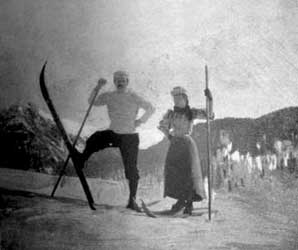
|
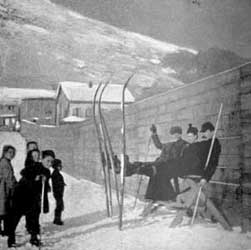 |
|
Conan
Doyle and his first wife Louise in the Alps, in 1893 |
The
Swiss boys staring at Conan Doyle and his friends might never
have seen skis before |
The famous
Grosvenor Hotel can be seen near the top of the map, next to Victoria
Station, from which Holmes and Watson left London for the Continent |
||
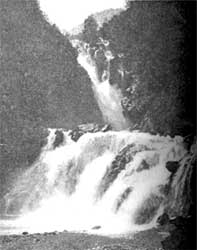 |
||
| Reichenbach Falls, from the guidebook at left. Compare this picture to Paget's conception of Reichenbach. | ||
The Gemmi Pass leads past the Daubensee, a small, high altitude lake (over 7,000 feet above sea level).
It was on the third
of May that we reached the little village of Meiringen, where we
put up at the Englischer Hof, then kept by Peter Steiler the elder.
Meiringen—in legend, the birthplace of meringue—was
known for being especially accommodating to English visitors in
Conan Doyle's time. He stayed there several times. Today, there
is a Sherlock Holmes museum in Meiringen—advertised as the
most authentic in the world—where it is possible to buy a
combined ticket to visit the museum and tour the Reichenbach Falls.
Our landlord was an intelligent man and spoke excellent
English, having served for three years as waiter at the Grosvenor
Hotel in London.
A venerable London hotel located near Buckingham Palace.
...with the intention of crossing the hills and spending the
night at the hamlet of Rosenlaui....
Rosenlaui is a tiny village in a rugged gorge of the same name,
and serves as a welcome resting place for travelers between strenuous
hikes.
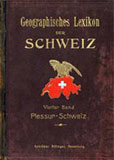 |
|
The
cover of a turn-of-the-century Swiss guidebook |
We had strict injunctions,
however, on no account to pass the falls of Reichenbach, which are
about halfway up the hills, without making a small detour to see
them.
Reichenbach Falls, one of the highest waterfalls in the Alps, consists
of five separate cascades down the side of a mountain. Today--an
even bigger tourist attraction because of its association with Holmes--it
can be visited by cable railway. In the terminal is a plaque commemorating
Holmes's "death" at the falls.
She had wintered at Davos Platz and was journeying now to join her friends
at Lucerne, when a sudden hemorrhage had overtaken her.
Tuberculosis and its deadly effects were much on Conan Doyle's mind
because of his wife's precarious condition. The scenario described
here must have been his worst nightmare.
There was Holmes's Alpine-stock still
leaning against the rock by which I had left him.
Holmes's sturdy walking—stick still leans against the rock—a
poignant reminder of his absence. The Alpine-stock, the silver cigarette
case, the little scrap of paper—these have become icons of
Holmes's disappearance (the deerstalker cap has slipped into films
of "The Final Problem," although it does not appear in the original
text).
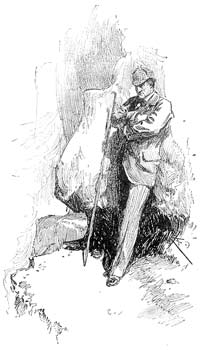 |
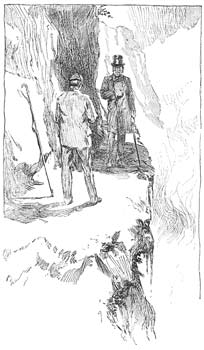 |
|
"As
I turned away I saw Holmes, with his back against a rock
and his arms folded, gazing down at the rush of the waters.
It was the last that I was ever destined to see of him in
this world." |
"'My
dear Watson,' he said, 'I write these few lines through
the courtesy of Mr. Moriarty, who awaits my convenience
for the final discussion of those questions which lie between
us.'" | |
The Case of the Resurrected
Detective: "The Empty House"
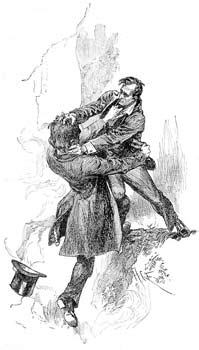 |
| "An
examination by experts leaves little doubt that a personal
contest between the two men ended, as it could hardly fail
to end in such a situation, in their reeling over, locked
in each other's arms." |
By 1893, Arthur Conan Doyle
had written 24 stories and two novels about the great consulting
detective, Sherlock Holmes, and his chronicler, John Watson. Conan
Doyle's other works, while successful, did not approach the success
of the Holmes stories. Conan Doyle had long been tempted to kill
off his most famous character so that he, and the public, could
focus on what he considered to be his most important work.
Once "The Final Problem" had been printed and sold to an unsuspecting
public, Conan Doyle was shocked by the vehemence of the public reaction,
which included threats and abusive letters. "You Brute!" one letter
began. According to one possibly apocryphal story, a lady attacked
him with her umbrella when she met him in the street; another picketed
his house in protest. People wore black armbands as if a real celebrity
had died. Apparently, Conan Doyle was the only one who took his
famous detective less than seriously, and he had his reasons.
During the year that preceded the December death of Holmes, Conan
Doyle's father had died, and his wife had been diagnosed with a
particularly virulent form of tuberculosis, and was only expected
to survive for a few months. "I have been much blamed for doing
[Holmes] to death," Conan Doyle said in a speech, "but I hold that
it was not murder, but justifiable homicide in self-defense, since,
if I had not killed him, he would certainly have killed me." During
a sojourn in the Swiss Alps with his wife at a sanatorium for tubercular
patients, Conan Doyle determined upon the method of Holmes's death.
As 1893 came to a close, Conan Doyle's wife Louise began the cure
that would allow her to live for 13 more years, while Sherlock Holmes
(apparently) died. "Killed Holmes," Conan Doyle wrote in his diary,
and went on with his life.
Conan Doyle was finally inspired to write The Hound of the Baskervilles
in 1901 and a series of Holmes stories for The Strand (beginning
in 1903 with "The Empty House") by an offer he could not refuse:
The Strand and the American magazine Colliers
offered him more money than he had ever been offered for his writing
before. Discovering Sherlock Holmes will begin with "The
Empty House" when our next series starts in early 2007.
221B
Here dwell together still two men of note
Who never lived and so can never die:
How very near they seem, yet how remote
That age before the world went all awry.
But still the game's afoot for those with ears
Attuned to catch the distant view-halloo:
England is England yet, for all our fears--
Only those things the heart believes are true.
A yellow fog swirls past the window-pane
As night descends upon this fabled street:
A lonely hansom splashes through the rain,
The ghostly gas lamps fail at twenty feet.
Here, though the world explode, these two survive,
And it is always eighteen-ninety-five.
—Vincent Emerson Starrett (1886-1974)
Journalist, book-collector, mystery writer, and expert Sherlockian,
Vincent Emerson Starrett co-founded the Baker Street Irregulars
and wrote mysteries and books on Sherlock Holmes, including The
Private Life of Sherlock Holmes.
